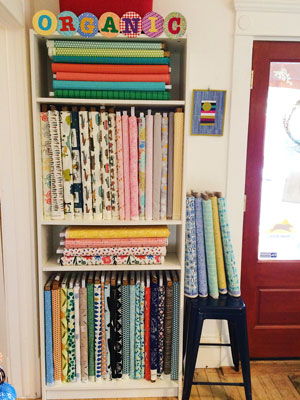Sustainable Alternatives to Quilting Cotton
By Shelly Sommer
In October, The Boulder Modern Quilt Guild, along with the Sustainability, Energy and Environment Community at University of Colorado Boulder, will present a modern quilt show, An Exploration in Sustainable Modern Quilting. In the next few weeks we will be posting some blog posts with information about sustainable quilting including sources for sustainable fabrics, how to clean recycled or reused fabrics, and more. Shelly has provided us with some great alternatives to quilting cotton.
When you start quilting, using cotton is the obvious choice. When you walk into a quilt shop you’re presented with colorful bolts of quilting cotton. There are so many options, it’s readily available, and it’s easy to work with. But there are environmental issues with cotton:
- Growing cotton takes a lot of water and pesticide – in fact, it uses more pesticides than any other crop.
- Fabric manufacture and dyeing is a major polluter of land and rivers. The textile industry is considered the second most-polluting industry after oil and gas production.
- The textile industry is notorious for exploitative labor practices.
Buying new fabric that is easier on the planet and people isn’t easy but it’s definitely doable. Here are some options to consider:
LINEN
Made from the flax plant, linen requires much less water than cotton and hardly any fertilizer or pesticides.
Linen is usually sold as solids and the color choices are limited. But it’s natural khaki shade is available without any additional dyeing.
Linen has a loose weave that makes it less stable than quilting cotton so you will probably need to use starch. Linen isn’t ideal for precise piecing, but works well for piecing curves.
HEMP
Like linen, hemp is made from a plant that requires little water, fertilizer, or pesticide and is easy on farmland.
Hemp can be woven into a sturdy, smooth fabric that looks similar to linen, or into knits like jersey.
Because hemp is made from the Cannabis sativa plant, it was banned from commercial production until recently. Colorado, among many other states, is starting to license agricultural production, which may lead to more domestically- produced hemp fabric becoming more available.
MODAL, LYOCELL, TENCEL
These fibers are all made from cellulose and are the most ecofriendly types of rayon. Raw materials are sustainably managed beech or eucalyptus trees or bamboo, and manufacturing uses closed-loop systems that recapture chemicals instead of dumping them into rivers.
Fabrics made from these fibers are soft and lightweight and are used more for clothing than quilting. However, they can be fun to experiment with and can add bits of softness to the structure of a quilt block. Fancy Tiger usually has an interesting selection of these fabrics in various weights.
RECYCLED POLYESTER
Polyester is a petroleum product that never biodegrades and requires much more energy (though much less water) to manufacture than almost any other fabric. So usually it wouldn’t be considered a sustainable fiber. Recently, however, recycled polyester fabrics have become available that reuse polyester fibers that might otherwise wind up in the environment. Most of these are knit fabrics. Worth experimenting with!
NATURAL FIBER BLENDS
Cotton can be blended with silk, bamboo, linen, or hemp to make fabrics that have less of an environmental footprint than straight cotton. They often combine the best qualities of both fabrics: for instance, silk-cotton blends have the soft hand of silk but the strength and washability of cotton. Look for chambrays, solids, and prints.
Some cottons are better than others: try these as alternatives.
AMERICAN COTTON
Solids from American Made Brand (a division of Clothworks) are made from cotton that is grown, spun, woven, and dyed in the United States. It has a smaller carbon footprint, since the fabric hasn’t been shipped around the world twice by the time it gets to you; and labor conditions aren’t a concern.
Their color palette is limited, and their colors aren’t as consistent from batch to batch as Kona.
JAPANESE COTTON
Factories in Japan are monitored much more carefully than competitors elsewhere in Asia. They also regulate the use of chemicals like formaldehyde (unlike the U.S.). This makes Japan a clear winner in labor practices and the environmental footprint of the manufacturing process.
COTTON MADE FROM ENVIRONMENTALLY RESPONSIBLE FACTORIES
Hoffman Fabrics owns their factory in Bali, and it uses a water filtration system that removes dyes and other chemicals from the manufacturing process from the water before it leaves the factory. This makes Hoffman lines made there (Indah batiks, Me + You) easier on the surrounding environment and communities.

ORGANIC COTTON
Organic cotton skips the heavy pesticides that make cotton hard on land and water, but it can take more water to grow than regular cotton.
Lines like Amy Butler “Organic Soul” and Cloud9 use both organic cotton and low impact dyes. In addition, Cloud9 has a commitment to the ethical treatment of workers in its manufacturing facilities.
Our Sustainable Quilting Pinterest board has inspiration and ideas for the show. If you come across any great quilts, send them our way! And please, let us know if you have any questions you’d like us to answer about the quilt show or sustainable quilting in general.


